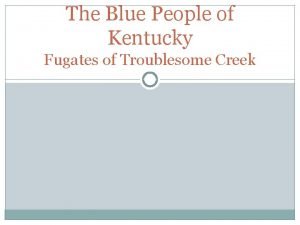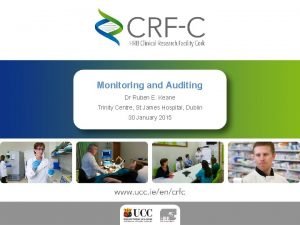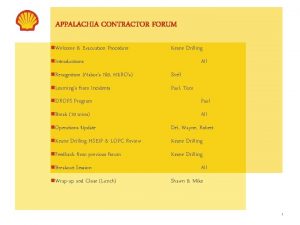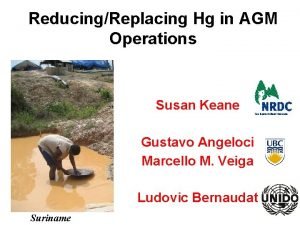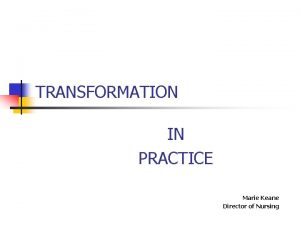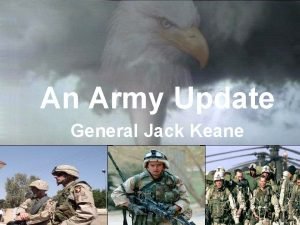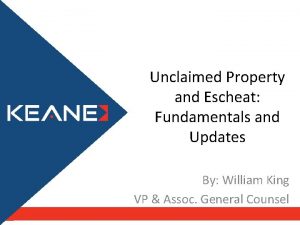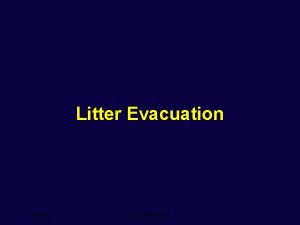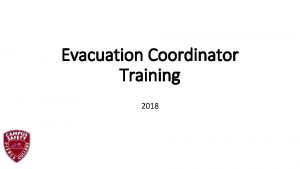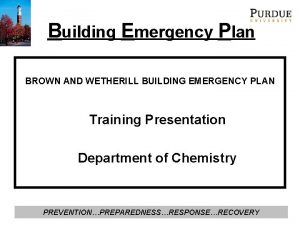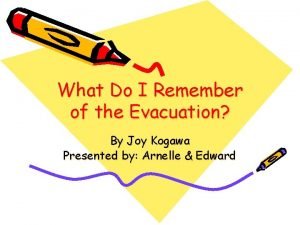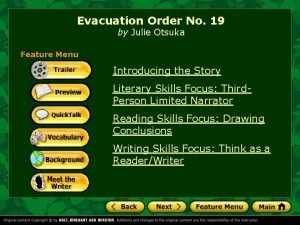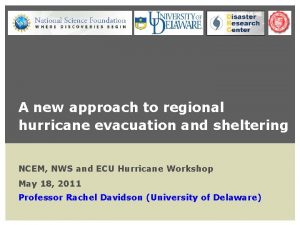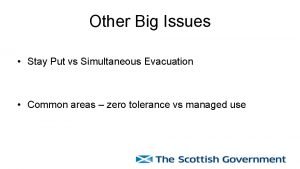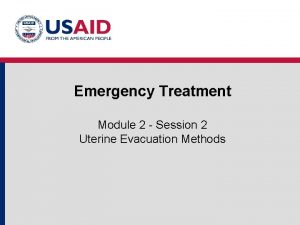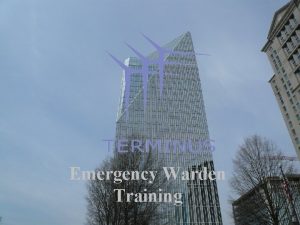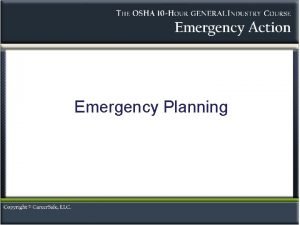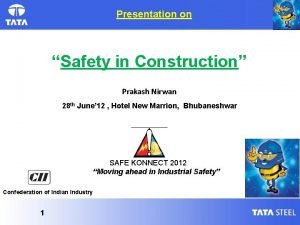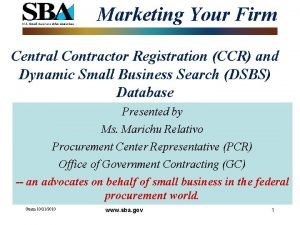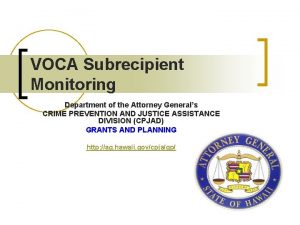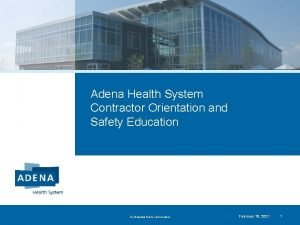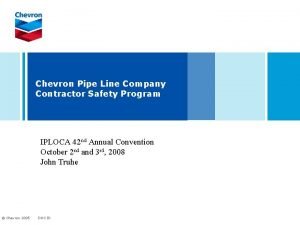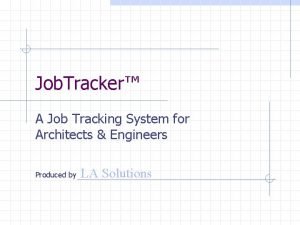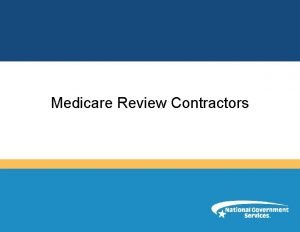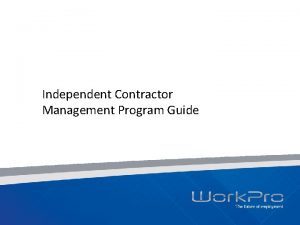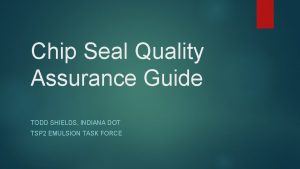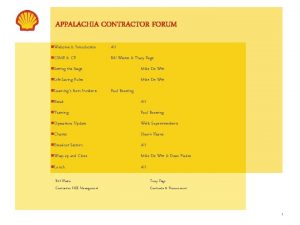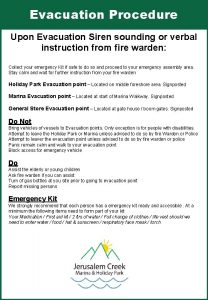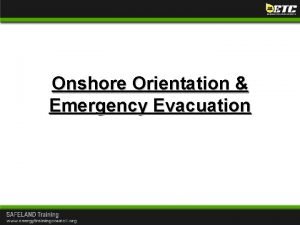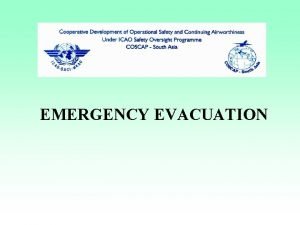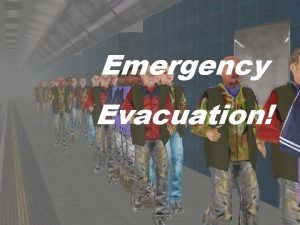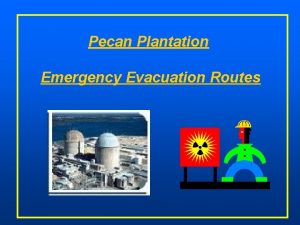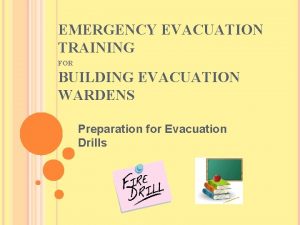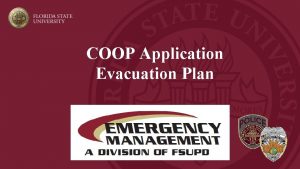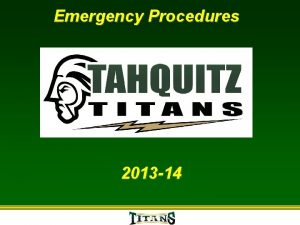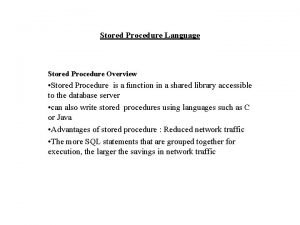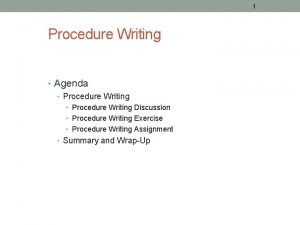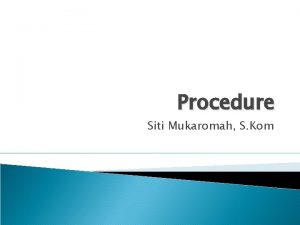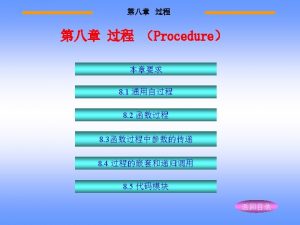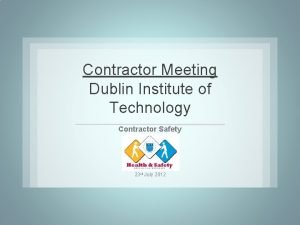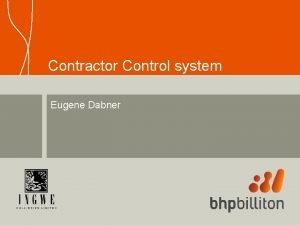APPALACHIA CONTRACTOR FORUM n Welcome Evacuation Procedure Keane







































- Slides: 39

APPALACHIA CONTRACTOR FORUM n. Welcome & Evacuation Procedure Keane Drilling n. Introductions n. Recognition n. Learning's n. DROPS n. Break from Incidents Program (10 mins) n. Operations n. Keane (Nabor’s 789, HERO’s) Update Drilling HSEIP & LOPC Review n. Feedback from previous forum n. Breakout Session n. Wrap-up and Close (Lunch) All Shell Paul, Tom Paul All Del, Wayne, Robert Keane Drilling All Shawn & Mike 1

PENN COLLEGE – EVACUATION UPPER PARKING DECK (muster area) 2

INTRODUCTIONS n For all first attendees to the forum, please provide the following: n Your Name n Position n Service provided to Shell 3

RECOGNITIONS n Nabor’s Rig 789 Wayne Mc Leod – Drilling Superintendent n HERO’s Paul Broering – HSE Tech Supervisor 4

HOW MANY DAYS SINCE DRILLING HAD: A Fatality n (**None since start-up of PA on 7 -29 -2010) A Lost Time Injury n 156 – 156 (** None since start-up of PA on 7 -29 -2010) MVA– (Motor Vehicle Accident n 18 – 81 (**MTC – Fractured Finger– 01 -18 -11) A Spill (Reportable HC Spill/Release) n 55 – 55 (** NM – Drill rod falls from trailer – 12 -22 -10) Harm – (OSHA Recordable Injury) n 202 – 202 (** None since start-up of PA on 7 -29 -2010) An HPI (High Potential Incident) n 202 – 202 11 – 73 (** MVA – Employee Strikes a Deer – 02 -04 -11) 5

HOW MANY DAYS SINCE COMPLETIONS HAD: A Fatality n (**None since start-up of PA on 7 -29 -10) A Lost Time Injury n 202 – 202 (** None since start-up of PA on 7 -29 -2010) MVA– (Motor Vehicle Accident n 03 – 110 (** MTC – Lime Contacted Eye, 10 -19 -10) A Spill (Reportable HC Spill/Release) n 60 – 116 (** NM–Hydraulic valve closed during FRAC ops. 12 -17 -10) Harm – (OSHA Recordable Injury) n 202 – 202 (** None since start-up of PA on 7 -29 -10) An HPI (High Potential Incident) n 202 – 202 11 – 57 (** MVA - Front bumpers of trucks make contact, 02 -04 -11) 6

Learning From Incidents n FIRE-FLASH FIRE OCCURRED WHILE WELDING-Contractor rigged up to run and set conductor pipe for use as a mouse hole. Hot work initiated, and gas test showed no signs of LEL. Welder was completing the 2 nd weld when a flash fire occurred in the near by cellar (approximately 5’ away). There was no damaged to equipment or injuries to personnel. Additional information to follow as investigation is on going. 7

Learning From Incidents n FIRE – GAS IGNITES AT ROTATING HEAD. While modifying the flow-line, as the welder made his initial cut, gas that had accumulated in the flow line ignited at the rotating head. Manlift operator extinguished the flame. No injuries occurred. 8

Learning From Incidents Similarities: n Mixture of air and seeped gas resulted in flash fire during welding operations. n LEL tests were conducted prior to each operation, hazards of other possible “ignition sources” were not recognized. 9

Learning From Incidents n Rig Move Tom Swanson – Road Transport Lead 10

Introduction to the DROPS Prevention of Dropped Objects

Purpose n The purpose of Dropped Objects Prevention Scheme is to set out the mandatory requirements to prevent harm to personnel and damage to equipment from dropped objects in the execution of Shell’s drilling, completion and well intervention activities.

What is DROPS? n The Dropped Objects Prevention Scheme is designed to: n eliminate dropped objects from our business; n prevent harm to people from dropped objects; n prevent damage to equipment from dropped objects

Who is DROPS for? n All managers and supervisors n All drilling, completion and well intervention staff and contractors

What is the objective of the campaign? n To eliminate dropped object incidents by: n communicating the scale of the problem to everyone; n training key personnel on how to avoid dropped object incidents; n mobilising the workforce to play their part in eliminating the hazards; n complying with the mandatory DROPS requirements on a day to day basis on all sites Changing Behaviours

Definition of a dropped object n Dropped objects derive their capability for damage and harm from the conversion of their potential energy to kinetic energy prior to impact. n Potential harm to people is calculated via a DROPS calculator, which can be used to assess the impact of a dropped object.

Classification of Dropped Objects n For the purpose of focusing prevention and elimination strategies HIPO Definition: dropped or potential dropped objects are classified as either static or dynamic. • An unplanned HSE event (incident or near miss) which has the potential severity to cause permanent disablement or death. n Static Dropped Object: n A static dropped object is a solid object, initially at rest, that falls from • HIPOs will be restricted to high potential with respect to consequences on people and will include all its original position under its own weight. Examples of static dropped significant dropped objects and violation of Life Saving Rules. objects include nut dislodged in rig derrick, fallen cable tray due to failed (corroded) fastenings. n Dynamic Dropped Object n A dynamic dropped object is a solid object that breaks free from its fastenings due to the applied force from the impact of some other equipment or a moving object. Examples of dynamic dropped objects include the top drive hitting the rig floor, a stand of drill pipe falling across the derrick and hitting and breaking a light resulting in the light falling to the rig floor.

Prevention of Dropped Objects Manual – EP 2009 -9039 Principle 1: Contractors providing equipment and personnel on Shell well sites shall have a Dropped Object Prevention Scheme Principle 2: A systematic dropped object inspection programme shall be in place. Principle 3: Worksite Hazard management for dropped objects shall be in place. Principle 4: Audits to check for compliance with Dropped Object Prevention Scheme shall be in place. Each principle has a series of mandatory requirements

DROPS Campaign Topics n Campaign Topics • Tools at Height • Red Zones and No Go Zones • Tubular handling • Lifting and hoisting • Job safety analysis • Handling lubricators and tool strings n Deliverables per topic • Awareness videos (language free) • Posters • Quick reference cards • Articles for internal and external newsletters • Presentation for safety meetings/training packs

Forbidden Equipment and Practices n Numerous incidents have occurred as a result of misuse of equipment, lack of maintenance or misplaced creativity by individuals trying to get the job done. To avoid such incidents, the following high risk items are forbidden. n Uncertified lifting equipment including ‘home made’ lifting devices. n Surface drill pipe filters. n Use of hammers with wooden handles at height. n Bolts secured with a double nut arrangement. n Use of welding rods/wire/tie wraps instead of properly engineered split pins or safety pins. n Use of hooks on any part of the rigging on winch lines and stabbing board. n Slings wrapped around derrick/mast beams. n Unsecured water bottles, grease tubes/guns, etc. . n Drifting stands in the derrick without a formally documented procedure and JSA detailing how the No-Go or Red Zones will be controlled.

Examples of unacceptable conditions Severely corroded lifting eyes Loose full water bottle at crown Ineffectively secured equip at crown No crown sheave bumper block Badly corroded socket at crown Badly corroded handrail at crown Redundant and non-safety type shackle Some loose items retrieved

What is the role of the Drops Focal Points? n Knowledge of Prevention of Dropped Objects Manual and its intent n Communication of requirements to your teams, including contractors n Track status of compliance with mandatory requirements n Distribution of ABC Guide to Dropped Objects Prevention n Distribution of other campaign materials (posters, videos, handouts) n Co-ordination of gap analysis and compliance action planning n Securing management support - allocation of your time to this task n Running briefing sessions for DROPS Leads

How will it be implemented? People • DROPS Focal Points responsible for ensuring compliance with mandatory requirements • DROPS Leads assigned to run campaign at their location • Line accountability and individual’s responsibility Training • Cascaded learning sessions across office, well site, contractors • Train the trainer sessions • DROPS Leads to run the campaign at their location and train/coach staff Communication • Presentation for managers and supervisors • Regional DROPS Focal Points Forum – clarify expectations, share learning, monthly teleconference • Articles for internal and external publications • DROPS website • Posters Issue of manuals and guidance • Prevention of Dropped Objects Manual • ABC Guide to Dropped Object Prevention • Gap Analysis Template • Awareness videos to convey key messages

DROPS Campaign Timescale n. WALT endorsement, Prevention of Dropped Objects manual issued July 2009 n. Regional DROPS Focal Point meeting March 2011 n. Appointment of PA asset DROPS focal points February 2011 n. Appointment of Wellsite DROPS Leads for each location March 2011 n. Meetings with contractors March 2011 n. Gap analysis and correction planning carried out at each location/work group Now – May 2011 n. Operational implementation Nov 2011 onwards, including availability of video material n. Compliance with mandatory requirements by 01 Jan 2012 n. Auditing throughout 2011 n. Copy of DROPS gap analysis template Rev 2. xlsx

What happens next? n. Manual roll out (confirm your staff and contractors have received this). n. Plan for cascade sessions (use this pack) with staff and contractors. n. Action plans for gap analysis and implementation to be completed with DROPS Focal Points and DROPS Leads. n. Full implementation of the Prevention of Dropped Objects Manual and mandatory requirements to be completed by 1 January 2012. n. Audit of compliance 2012. n. DROPS gap analysis corrective action plan. xlsx

BREAK 26

OPERATIONS UPDATE n Del Southwell – Drilling Superintendent n Wayne Mc Leod – Drilling Superintendent n Robert Smith – Completions Superintendent 27

Keane Companies SAFETY HEALTH & ENVIRONMENTAL TRIR REDUCTION/IMPROVEMENT GOALS 2011

HSE Improvement Plan § 50% reduction in accidents/incidents for the remainder of 2011 with in our operations. § 50% Reduction in Total Recordable Incident Rate (TRIR) for 2011 fiscal year. § 50% Increase with employee involvement with workplace observations/reporting. § 100% Participation in all on-site safety briefings, JSA development / review’s and work related procedures prior to the commencement of your task. § 100% Involvement in all company / client safety related activities, safety briefings, and safety meetings. § 100% understanding of Keane & Sons Drilling (KSD) newly established HS&E responsibilities and accountabilities.

HSE Improvement Plan – Continued § 100% Increase in Management / Supervisor / Employee involvement in quarterly safety committee meetings. § 50% Increase in on-site safety visits by Managers that focus on at risk conditions and at risk behaviors, while assisting and mentoring all SSE employees. § 50% Reduction in reportable spills by developing additional spill control techniques to minimize spillage. § 50% Increase with corrective action process, as well as improvements in the developing of JSA’s, and workplace procedures for continuous work place improvements. § 50% Increase in the understanding of the use of “take 5/for safety” or improved emphasis on the process of “Pause” during operations to review JSA / Work Procedures. § 100% Increase in the involvement of Supervisors while conducting any designated high risk task.

Responsibilities & Accountabilities – HSE PERSONNEL ATTEND AS MANY SAFETY MEETINGS AS YOU CAN EACH WEEK, FOCUS ON NEW EMPLOYEE’S SAFETY DEVELOPMENT, NEAR MISSES, AND CLOSE CALLS. FOLLOW UP AND ASSIST IN THE DEVELOPMENT OF JSA’s AND WORKPLACE PROCEDURES. § MAKE DAILY SITE VISITS IN ORDER TO SUPPORT CURRENT HS&E PROGRAM, PERFORM WORKPLACE OBSERVATIONS DURING EACH SITE VISIT § WORK WITH EMPLOYEES SO THEY ARE DEVELOPING SOUND SAFE BEHAVIORS AND IMPROVING ON SAFETY SKILLS. § SUPPORT ALL PRO-ACTIVE SAFETY ACTIVITY, AND ENCOURAGE ALL EMPLOYEES TO IMPLEMENT THE STOP WORK AUTORITY § ASSIST IN TRAINING AND EDUCATION OF ALL NEW EMPLOYEES TO ENSURE THEY DEVELOP THE RIGHT SAFETY HABITS. § BE ON LOCATION ANY TIME THERE IS A “HIGH RISK JOB” BEING PERFORMED TO ENSURE THAT THE HIGHEST LEVEL OF SAFETY IS MAINTAINED. § RESPONSIBLE FOR ENSURING THAT ALL POLICIES AND PROCEDURES ARE BEING FOLLOWED OR THAT MAY NEED TO BE REEVALUATED DUE TO CONDITIONS THAT HAVE CHANGED WITHIN THE TASK. § WORK WITH ALL EMPLOYEES TO IMPROVE THEIR UNDERSTANDING OF KSD SH&E IMPROVEMENT PROGRAM. § STIMULATE POSITIVE ATTITUDES, EDUCATE, LISTEN TO EMPLOYEE PROBLEMS, AND ADDRESS THEIR CONCERNS. § SET GOALS FOR ALL EMPLOYEES. CONSTANTLY ENFORCE EXPECTATIONS AND ASK YOUR SUPERVISORS AND EMPLOYEES THE FOLLOWING QUESTIONS ON A REGULAR BASIS §

KEANE-LOPC, Incident Review – Description n While changing fuel filters on the compressor skid, an employee inadvertently opened an oil fill valve coming off the oil storage tank. The valve was closed as soon as it was noticed that oil was leaking out onto the secondary containment. It was estimated that approximately 4 -6 gallons of the compressor oil had leaked onto the containment. Employees immediately notified the HS&E rep on-site and cleaned up the spill with absorbent pads and sawdust. 32

KEANE-LOPC, Incident Review – Causal Factors n Due to the design of the piping coming off the bottom of the tank, it was possible for personnel walking near the skid to accidently strike the closed valve with a leg or any object being carried, opening the valve to atmosphere. A “spigot” valve had been installed downstream of the main control valve but it had been left open at the time, allowing stored oil to flow onto the containment once the valve was opened. Had the “spigot” been closed the spill would not have occurred. 33

KEANE-LOPC, Incident Review – Corrective Actions n Upon further review and discussion with the Drilling Superintendent, it was decided that the bolt through the “safety closure” would be a temporary fix until all of the oil currently in the storage tank was drained out. Once the tank has been emptied, the piping will be removed and the drain holes in the tank are to be plugged or the tanks removed all together. If, at some point it is determined that the storage tanks will continue to be used, once the stored oil is completely drained, the plumbing on the tanks is to be redesigned to prevent any spill of this nature in the future. The piping should be arranged so that if there is any spill, it will be contained within the primary containment pan on the compressor skid. 34

REPORT OUT FROM PREVIOUS FORUM – Highlights n Attendees: 1 n 1 Senior Management/Operations n 1 Senior HSE Representative n 1 Line Supervisor (rotate in to observe and provide field input) n Timeline: n Same ½ day schedule but moved to middle of month and on Wed n Breakout Sessions will generate reports at the next meeting. Actions from these reports will be implemented with progress given monthly 35

BREAKOUT SESSION n Loss Of Primary Containment? n What immediate steps can be taken to prevent LOPC and when? n What are some long range plans (training, awareness programs, etc) that we can implement and when? 36

Closing, Ask Yourself WHY DON’T WORKERS FOLLOW SAFETY RULES AND PROCEDURES? n Safety is someone else’s job/responsibility n Safety is not a core value at (Your Company) n Safety is miss-understood n Workers are not held accountable for safety n Workers have a poor attitude towards safety

QUESTIONS? n Open Discussion/ Q&A n Next Forum: March 16 th 38

 Trans appalachia
Trans appalachia The blue family
The blue family Exemple de procedure d'evacuation incendie
Exemple de procedure d'evacuation incendie Ruben keane ucc
Ruben keane ucc Keane drilling
Keane drilling Susan keane south africa
Susan keane south africa Lisa marie keane
Lisa marie keane General jack keane
General jack keane Marta keane
Marta keane Lighthouse puppy linux
Lighthouse puppy linux Keane unclaimed property letter
Keane unclaimed property letter Kelvin keane
Kelvin keane Dan nordquist wsu
Dan nordquist wsu Fergal keane wife
Fergal keane wife Wise men three clever are we
Wise men three clever are we Intraosseous antibiotics
Intraosseous antibiotics Evacuation
Evacuation Linear danger area hand signal
Linear danger area hand signal Evacuation coordinator
Evacuation coordinator Reverse triage evacuation order
Reverse triage evacuation order Evacuation procedures
Evacuation procedures What do i remember of the evacuation poem
What do i remember of the evacuation poem Pente evacuation wc
Pente evacuation wc Evacuation order no.19
Evacuation order no.19 Evacuation modeling
Evacuation modeling Emergency evacuation training
Emergency evacuation training Emergency evacuation training
Emergency evacuation training Floor warden training
Floor warden training Voice evacuation message
Voice evacuation message Evacuation officer
Evacuation officer Evacuation action
Evacuation action Hard barrication standards
Hard barrication standards Small dynamic business search from the ccr home page
Small dynamic business search from the ccr home page Subrecipient vs contractor
Subrecipient vs contractor Ahs contractor
Ahs contractor Chevron tenets of operation
Chevron tenets of operation Agricultural contractor job tracker
Agricultural contractor job tracker Northeastern unified program integrity contractor
Northeastern unified program integrity contractor Independent contractor management system
Independent contractor management system Todd shields contractor
Todd shields contractor

